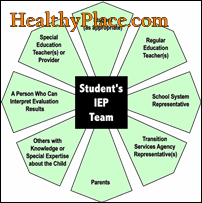Write a Portrait of Your Child: Preparing for the IEP Meeting
 To be an effective advocate for your child you must learn how to be on an equal footing in IEP meetings. You must be able to articulate your concerns and thoughts, which means careful preparation. Such preparation, while time consuming, will pay off handsomely. Preparation will give you a head start on getting your concerns and recommendations documented and considered by the other IEP team members.
To be an effective advocate for your child you must learn how to be on an equal footing in IEP meetings. You must be able to articulate your concerns and thoughts, which means careful preparation. Such preparation, while time consuming, will pay off handsomely. Preparation will give you a head start on getting your concerns and recommendations documented and considered by the other IEP team members.
The written record of the meeting is what counts if there is ever a dispute about what was said or what happened during an IEP meeting. While the district takes the official minutes, you as the parent are entitled to have your input included in the record. The best way to ensure your concerns and recommendations are in the record is to take them to the meeting in writing. You can then ask to read them out loud and request they be included with the minutes as part of your parent input to the meeting. The following strategies can assist you in accomplishing this task.
Both the U.S. Department of Education and a State Department of Education have told me of a new way to write a present level of performance that describes the whole child, his strengths, weaknesses, and needs. Rather than one PLOP here and one there, this new approach can offer a total picture of the whole child. Parents can adopt this technique, thus helping the team see their child in a new way.
Through experimentation, trial and error, I refined this idea and developed the "Portrait" as a way for parents to present crucial information to the IEP in a concise, thoughtful manner. Only we "write" the portrait, rather than "paint" the portrait. By writing a "portrait", you can see that no strengths, weaknesses, or needs, as you know them, are overlooked by the team. While the team will write the official present levels of performance, such input from a parent is very powerful. IDEA recognizes that parents have unique knowledge of their child, knowledge that is crucial to successful planning of placement and services.
It has been gratifying to have positive feedback from administrators on parents using this approach to present parent input for an IEP meeting. They have expressed their appreciation to parents for presenting such a concise, informative document that spells out their concerns and unique insight on their child.
Writing "A Portrait"
Writing what amounts to a portrait of your child is a powerful tool for parents to use. Such a document can help keep the team directed towards your child's strengths, weaknesses, and educational needs. It is important to get your child front and center quickly at an IEP meeting. By reading your "Portrait" at the very beginning of the meeting you will immediately see the focus shift to its appropriate place, the needs of your child.
Benefits for both parents and the district
Such parent documentation can help keep districts in compliance with the law, since all information, including parent input, is to be carefully considered. Since parents are equal participants, a written record of parent input can clarify issues and concerns, and reduce the level of confusion sometimes present at a meeting. Parents can request that this document becomes part of their official parent input to the meeting by making that request in writing at the end of their "Portrait". Districts have been very cooperative in this effort to see that parent input is treated as equal in importance to district minutes.
As a parent, I know how very difficult it can be to tie down your parental concerns to specifics. But as you go through this exercise you may find your vision of your child and his or her needs come into sharper focus. You may be surprised at how much you learn about your child as you create your portrait. You will be better prepared at the meeting to ask those all important questions regarding how your child's needs will be met. Your knowledge of his or her strengths, weaknesses, likes, dislikes, fears, and dreams is unique and very necessary to the total picture of the child.
Step One: Document all of your child's needs in writing
Since the team is required to address all of the child's needs, it is necessary to assemble all of the pertinent information you have, including the last multi disciplinary evaluation, any medical or therapist's evaluations, information from good articles or books that pertain to your child's disability and possible needs, and your own invaluable knowledge of the needs. As you thumb through all this information, pick out all the needs you think are pertinent at this time. Write down each one as you find it. Since this is detailed work, it is best to do this exercise before you write your portrait. Think of it as assembling the essential materials before you start painting. If you try to skip this step, you may get bogged down in the details and "not see the forest for the trees" when it is time to complete the portrait.
Step Two: Paint the background
Think of the background of your portrait as would an artist. You want to show the overall colors that will set the scene for the details. For your portrait, you will write a description of your child, his personality and nature, how the disability impacts education and/or social skills, and describe any fears or frustrations. Weave into the background just a few education specifics at this time.
You will likely find it very difficult to accomplish the next step, which is to cut it down to no more than one third of a page! The shorter you make it the greater the impact will be on the team. They are more likely to pay attention. Now you will have to slash and burn, but it will be with purpose. You must choose only the most important facts.
Step Three: Insert your list of needs
This is your opportunity to see that the team considers each and every need documented in all your reports, evaluations, research, and personal observations. This is where you go into great detail. Do not worry about the length of the list. Do not worry about whether everyone will pay attention throughout your reading of this portion. The important thing is to get it into the written record of the meeting for consideration. Number each need. By numbering each need, each team member, including you, can track which needs have been addressed and which ones have not been addressed. You have a quick reference tool, in writing.
Parents often find reading articles and books on the relevant disability or disabilities helpful when assembling this list of needs. Such a book or article can put into words what we as parents often know but have difficulty putting into words. After all, we are not professionals. As you read, pick out those things that make you think "That's Johnny!" and "Yep, that is him!" or "It is like they wrote the book about Johnny!" Of course not everything will apply, as no two children are alike. Parents must be very careful to select only those characteristics that really describe their child. This exercise can help add the appropriate details onto your portrait canvas.
Step Four: Summing it up
It is important to end the portrait on a positive note. This is a great place to write a brief description of your child's dreams for the future, what he or she wants to become, whether the child wants to go to college, live independently, etc. Include your dream for your child as well.
Again, keep this paragraph very brief if you want to keep the team's attention. Often parents want to include a statement that they want to see their child become a successful adult with a career and able to live independently.
Points to remember
-
Be sure to take enough copies for everyone on the team to have their own copy.
-
Keep yourself on task by reading the entire Portrait uninterrupted.
-
Write on the document that you wish the Portrait to become part of the written record, as it is part of your parent input to the meeting.
-
Do not list any recommendations in this document. The portrait is simply your assessment of present levels of performance.
-
Write a second document of Recommendations for Team Consideration and present it when the team reaches the point of considering what services and placement are needed. (Trying to mix the two into one document dilutes the effectiveness of both.)
-
Remember to take plenty of copies so each person can follow along and digest the information as you read it out loud.
next: The Wild Child ADHD Homepage
~ back to Parent Advocate homepage
~ adhd library articles
~ all add/adhd articles
APA Reference
Staff, H.
(2007, June 7). Write a Portrait of Your Child: Preparing for the IEP Meeting, HealthyPlace. Retrieved
on 2025, December 19 from https://www.healthyplace.com/adhd/articles/write-a-portrait-of-your-child-preparing-for-the-iep-meeting

